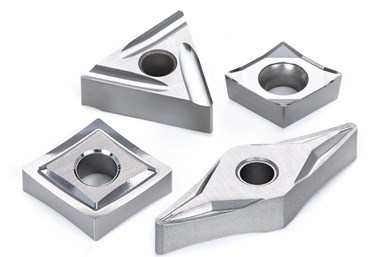Negative Inserts Improve Productivity in Non-Ferrous Metal Machining
Tungaloy expands its economical, double-sided negative insert line with the -28 chipbreaker.
Tungaloy America Inc. has enhanced its uncoated cemented carbide insert line for non-ferrous applications by adding 13 new inserts with the -28 chipbreaker.
Aluminum alloys are the most common weight reduction materials in the automotive and aerospace industries, which are said to be so machinable that uncoated carbide inserts can generally provide extremely long tool life. Likewise, copper alloys are widely used for seals, gaskets and o-rings in plumbing applications.
Conventional machining methods of non-ferrous metal parts employ positive turning inserts with a high positive rake and sharp cutting edges. These inserts, however, can only be used on one side, thus generating higher cost per edge and part.
Tungaloy says it addresses the issue by expanding the economical, double-sided negative insert line with the -28 chipbreaker. Featuring a pressed-in chipbreaker geometry with a large inclination angle on the sharp cutting edge, the -28 reportedly generates free cutting action with superior chip control. In addition, a negative insert design provides the cutting edge with strength and reliability when machining parts with heavy cutting conditions at varying depth of cut (DOC).
The inserts are available in KS05F grade. An uncoated, cemented carbide grade with submicron grain, KS05F provides the insert with wear resistance. This enables the new negative inserts to ensure long and predictable tool life over a wide range of non-ferrous applications.
The expansion includes standard ISO turning inserts in economical Class M tolerance, as well as ground-to-size inserts for precision finishing, encompassing finish to medium cutting of non-ferrous metal parts.
Related Content
-
New Modular Tool Options for Small Spindle Milling
Tooling options have been limited for small spindle milling applications. Now modular, indexable systems are available that provide broad flexibility to get the right cutter for the job with less inventory and at lower cost.
-
Best Practices: Machining Difficult Materials
Cutting hardened steel, titanium and other difficult materials requires picking the right tools, eliminating spindle runout and relying on best practices to achieve tight part tolerances.
-
10 Tips for Titanium
Simple process considerations can increase your productivity in milling titanium alloys.









.png;maxWidth=300;quality=90)







